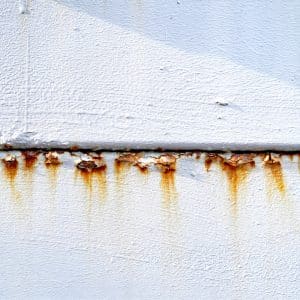Crevice corrosion is a localized form of metal degradation that occurs in confined spaces where access to oxygen is limited, such as under gaskets, seals, or overlapping metal joints. This corrosion type occurs when stagnant moisture or solutions become trapped, creating an environment fostering aggressive attack on metal surfaces.
The process begins with depletion of oxygen levels in the crevice, disrupting the protective oxide layer that naturally forms on many metals. This leads to an imbalance in electrochemical reactions, causing the trapped area to become highly acidic and corrode more rapidly than exposed surfaces.

Crevice corrosion is seen between two painted metal sheets.
Key Characteristics of Crevice Corrosion:
- Common Metals Affected: Stainless steel, aluminum, and other alloys prone to localized corrosion.
- Triggering Conditions: Presence of a narrow gap, stagnant fluid, and low oxygen levels.
- Industries Impacted: Marine, aerospace, and chemical processing, where moisture or aggressive environments are common.
Preventing Corrosion:
- Use corrosion-resistant coatings like thin dense chrome (TDC) to protect surfaces.
- Minimize crevices in design by welding or using continuous seals.
- Regularly inspect and clean equipment to remove trapped debris or moisture.
For more details on preventing this corrosion and protecting metal components, visit our dedicated pitting and crevice corrosion guide.